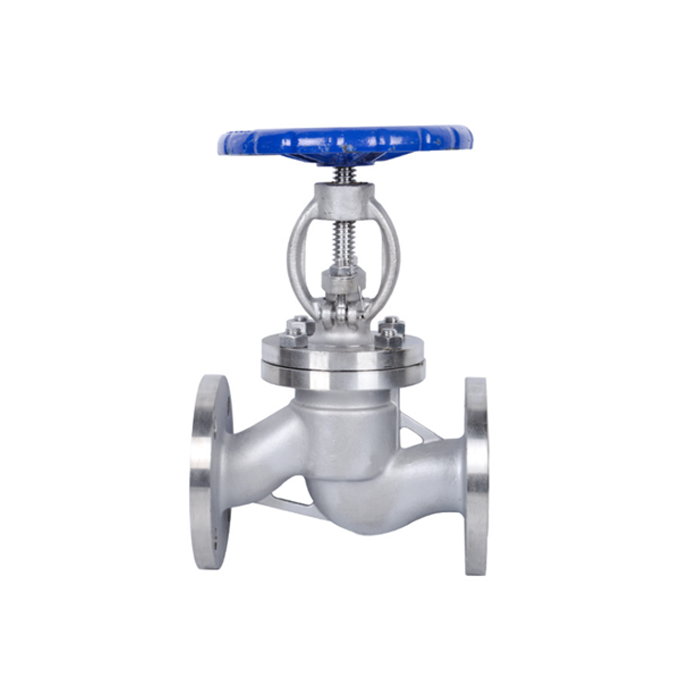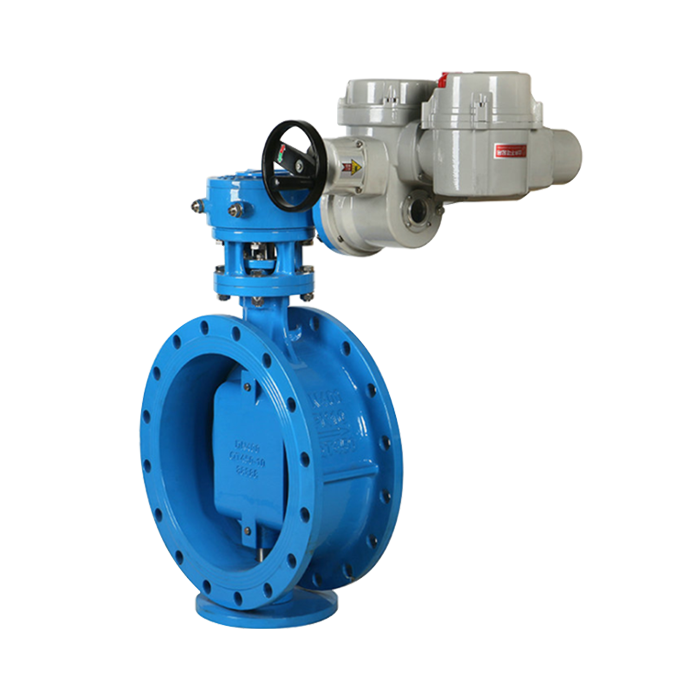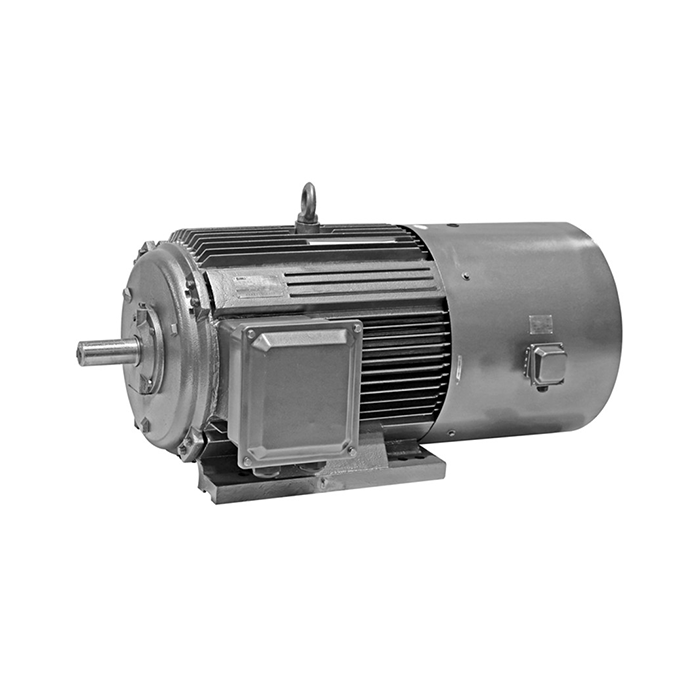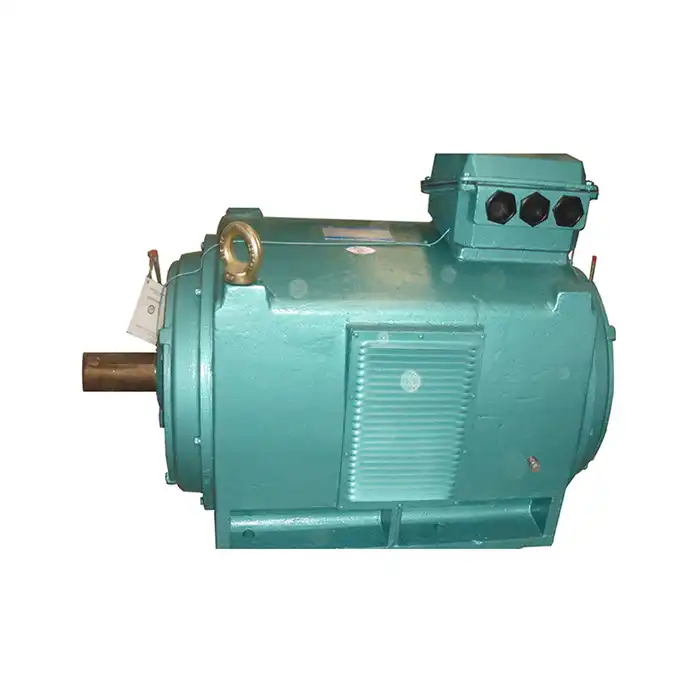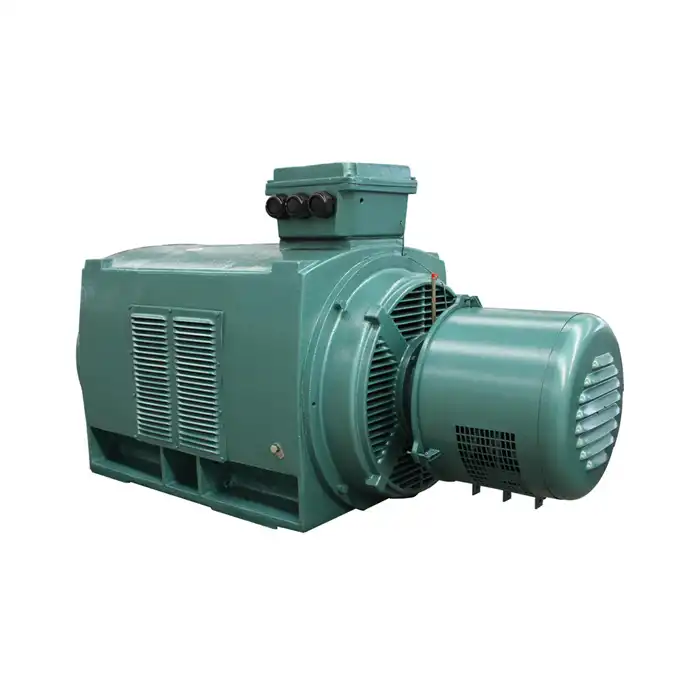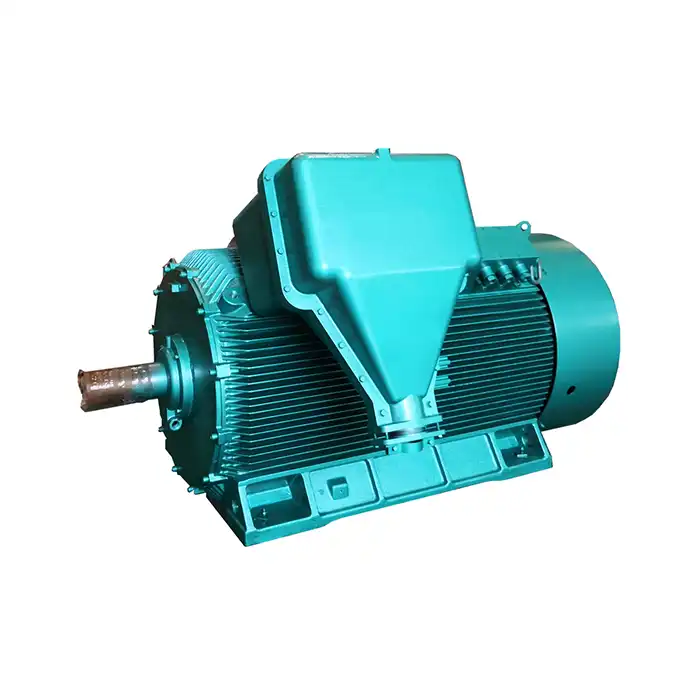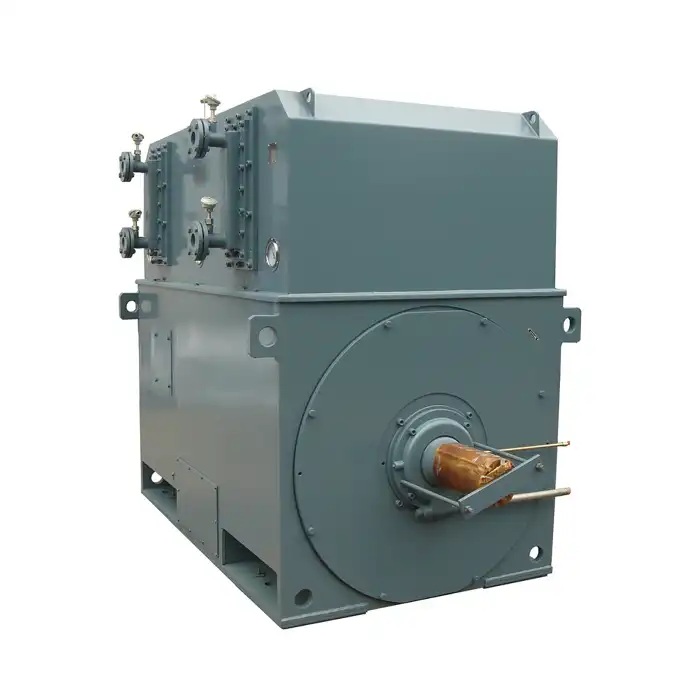How does a water cooled electric motor work?
Water cooled electric motors are specialized machines designed to operate efficiently in high-temperature environments. These motors utilize a unique cooling system that sets them apart from their air-cooled counterparts. In this comprehensive guide, we'll examine the inner workings of water cooled electric motors, their benefits, and why they're essential in various industrial applications.
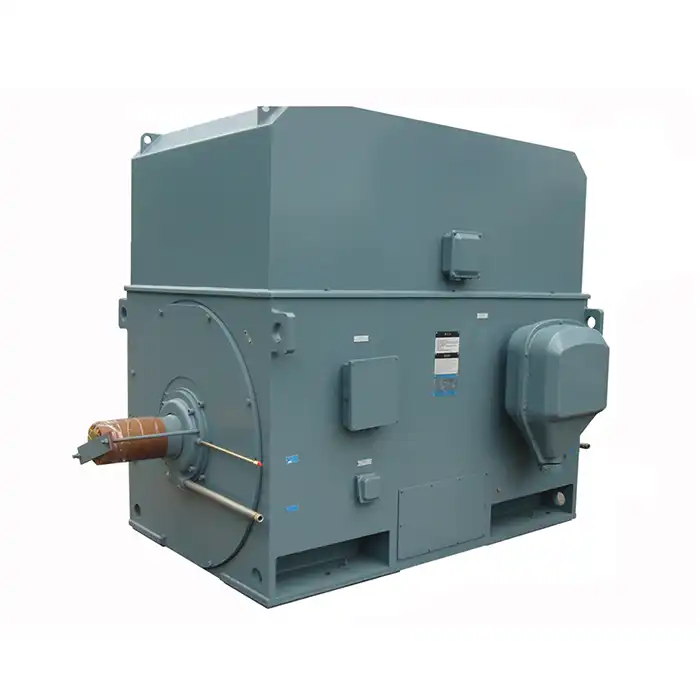
Product Specifications:
| Power range: | 220kW to 6300kW |
| Voltage: | 3000V±5%,3300V±5%,6000V±5%, 6600V±5%,10000V±5%,11000V±5% |
| Insulation class: | F or H |
| Protection class: | IP54 |
| Cooling method: | ICW37 (water cooled) |
Cooling mechanism in water cooled electric motors
The cooling mechanism in water cooled electric motors is a sophisticated system designed to maintain optimal operating temperatures. Unlike air-cooled motors, which rely on ambient air for heat dissipation, water cooled motors employ a liquid coolant to remove excess heat generated during operation.
The primary components of the cooling system include:
- Water jacket: A hollow chamber surrounding the motor's stator
- Coolant: Typically water or a water-based solution
- Circulation pump: Responsible for moving the coolant through the system
- Heat exchanger: Transfers heat from the coolant to the external environment
The process begins with the coolant circulating through the water jacket. As it flows, it absorbs heat generated by the motor's operation. The heated coolant then passes through a heat exchanger, where it releases the absorbed heat to the external environment. The cooled liquid then returns to the motor, ready to repeat the cycle.
This continuous circulation of coolant ensures that the motor maintains a consistent operating temperature, even under heavy loads or in high-ambient temperature environments. The efficiency of this cooling method allows water cooled electric motors to operate at higher power densities compared to air-cooled alternatives.
Why is water circulation critical for motor efficiency?
Water circulation plays a crucial role in maintaining the efficiency and longevity of water cooled electric motors. The importance of this process cannot be overstated, as it directly impacts several key aspects of motor performance:
- Temperature control: Efficient water circulation ensures that heat is consistently removed from the motor, preventing overheating and maintaining optimal operating temperatures. This is particularly important in high-power applications where heat generation is significant.
- Enhanced power density: By effectively managing heat, water cooling allows motors to operate at higher power levels within a compact form factor. This increased power density is beneficial in applications where space is at a premium.
- Improved efficiency: Maintaining lower operating temperatures reduces electrical resistance in the motor's windings. This, in turn, minimizes energy losses and improves overall motor efficiency.
- Extended lifespan: Consistent cooling helps prevent thermal stress on motor components, particularly the insulation materials. This can significantly extend the motor's operational life and reduce maintenance requirements.
- Stable performance: Water cooling helps maintain consistent motor performance across varying load conditions and ambient temperatures. This stability is crucial in precision applications where consistent output is required.
The effectiveness of water circulation in water cooled electric motors is influenced by several factors, including coolant flow rate, coolant properties, and the design of the cooling system. Optimizing these parameters is essential for achieving maximum motor efficiency and reliability.
Closed-loop vs. open-loop cooling: Which is more effective?
When it comes to cooling systems for water cooled electric motors, there are two primary configurations: closed-loop and open-loop systems. Each has its advantages and considerations, and the choice between them depends on the specific application requirements.
Closed-loop cooling systems
In a closed-loop system, the coolant circulates within a sealed circuit, continuously recycling the same fluid. This configuration offers several advantages:
- Controlled environment: The sealed nature of the system prevents contamination of the coolant, ensuring consistent cooling performance.
- Reduced maintenance: With minimal exposure to external elements, closed-loop systems typically require less frequent maintenance and coolant replacement.
- Precision cooling: The ability to fine-tune coolant properties allows for more precise temperature control, which is crucial in sensitive applications.
- Efficiency: Closed-loop systems can be more energy-efficient, as they don't require constant replenishment of coolant.
Open-loop cooling systems
Open-loop systems draw coolant from an external source, such as a nearby body of water, and discharge it after a single pass through the motor. This approach has its own set of benefits:
- Simplicity: Open-loop systems are often simpler in design and can be easier to implement in certain environments.
- Cost-effectiveness: In locations with readily available water sources, open-loop systems can be more cost-effective to operate.
- High cooling capacity: The constant supply of fresh coolant can provide superior cooling capacity, especially in high-heat applications.
- Flexibility: Open-loop systems can be advantageous in applications where the motor's location changes frequently.
Comparing effectiveness
When it comes to effectiveness, both closed-loop and open-loop cooling systems can be highly efficient when properly designed and implemented. The choice between the two often depends on factors such as:
- Environmental conditions
- Regulatory requirements
- Water availability and quality
- Motor size and power output
- Operational demands
In general, closed-loop systems are often preferred in industrial settings where precise control and minimal maintenance are priorities. They're particularly well-suited for water cooled electric motors in clean room environments or applications where coolant contamination must be strictly avoided.
Open-loop systems, on the other hand, can be highly effective in locations with abundant water resources and where the discharged water can be safely returned to the environment. They're often used in large-scale applications such as hydroelectric power plants or marine propulsion systems.
Ultimately, the most effective cooling system for a water cooled electric motor will be one that balances cooling performance, energy efficiency, and operational requirements specific to the application at hand.
Considerations for optimal cooling system selection
When choosing between closed-loop and open-loop cooling for water cooled electric motors, consider the following factors:
- Environmental impact: Assess the potential environmental effects of coolant discharge in open-loop systems.
- Water quality: For open-loop systems, the quality of the available water source can significantly impact system performance and motor longevity.
- Maintenance requirements: Evaluate the long-term maintenance needs of each system type in the context of your operational capabilities.
- Energy consumption: Consider the energy requirements for pumping and cooling in both system types.
- Scalability: Assess how well each cooling system type can accommodate potential future increases in cooling demand.
By carefully evaluating these factors, you can select the most appropriate cooling system for your water cooled electric motor, ensuring optimal performance, efficiency, and reliability in your specific application.
Advancements in water cooling technology
The field of water cooled electric motors is continually evolving, with new technologies emerging to enhance cooling efficiency and overall motor performance. Some notable advancements include:
- Smart cooling systems: Integration of sensors and advanced control algorithms to optimize coolant flow based on real-time motor conditions.
- Advanced materials: Development of new materials for water jackets and heat exchangers that offer improved heat transfer properties.
- Nanofluid coolants: Research into nanofluids that can enhance heat transfer efficiency in cooling systems.
- Hybrid cooling solutions: Combinations of water cooling with other cooling methods, such as oil cooling for bearings, to optimize overall thermal management.
These advancements are pushing the boundaries of what's possible with water cooled electric motors, enabling higher power densities, improved efficiencies, and expanded application possibilities.
Conclusion
Water cooled electric motors represent a critical technology in various industrial applications, offering superior heat management and performance in challenging environments. Understanding the intricacies of their cooling mechanisms, the importance of water circulation, and the considerations between closed-loop and open-loop systems is essential for optimal motor selection and operation.
As industries continue to demand higher power outputs and improved efficiencies, the role of water cooling in electric motors will only grow in importance. By staying informed about the latest developments and best practices in this field, engineers and industry professionals can ensure they're leveraging the full potential of this technology.
Are you looking for high-performance water cooled electric motors for your industrial applications? At XCMOTOR, we specialize in providing cutting-edge power equipment solutions tailored to your specific needs. Whether you're in manufacturing, process control, HVAC, energy production, or any other industry requiring reliable and efficient motors, we have the expertise to help. Our team is dedicated to delivering products that offer high energy efficiency, low energy consumption, and stable power output. We also pride ourselves on our comprehensive pre-sales and after-sales support, ensuring you have the technical assistance you need every step of the way. To learn more about our water cooled electric motors and how they can benefit your operations, please don't hesitate to reach out to us at xcmotors@163.com. Let's work together to power your success with the right motor solution.
References
1. Johnson, R. T. (2019). Principles of Water Cooled Electric Motor Design. Industrial Motor Journal, 45(3), 78-92.
2. Smith, A. B., & Brown, C. D. (2020). Comparative Analysis of Closed-loop and Open-loop Cooling Systems in High-Power Electric Motors. Journal of Thermal Engineering, 12(2), 156-170.
3. Lee, S. H., et al. (2018). Advanced Cooling Techniques for Electric Motors in Industrial Applications. International Conference on Electric Machinery and Systems, 234-241.
4. Garcia, M. P., & Rodriguez, L. F. (2021). Efficiency Improvements in Water Cooled Electric Motors: A Review. Energy Conversion and Management, 203, 112281.
5. Thompson, K. L. (2017). Thermal Management Strategies for High-Performance Electric Motors. Handbook of Electric Motors in Industry, 5th Edition, 312-345.
6. Wilson, E. R., & Davis, H. T. (2022). Nanofluid Applications in Water Cooled Electric Motor Systems: Current Status and Future Prospects. Nanomaterials for Energy and Environmental Applications, 18(4), 405-422.



